SHIBARI – ESTETICA ED ESTASI
Data: dal 21/06/2019 al 07/07/2020
Luogo: Oratorio Santa Maria Assunta, Spinea (VE)
Saturday 22 June, at 7 pm at the Oratory of Santa Maria Assunta SPINEA (VE), curated by Visioni Altre, the exhibition of the artist Hikari Kesho “Shibari in oratorio” will be inaugurated.
A PERFORMANCE BY HIKARI KESHO WILL FOLLOW AT THE OPENING.
AND SUBSEQUENT REFRESHMENT OFFERED TO ALL PRESENT.
The exhibition, open until 7 JULY 2019, organized by the cultural association Visioni Altre under the patronage of the Municipality of Spinea (VE).
Open to the public: from Thursday to Sunday from 3.30pm to 7.30pm Press release by Ilaria Ceri
“Bind me, annihilate me and finally drown me ..” (Patrizia Valduga)
Why choose such a poignant and particular theme for an exhibition as shibari? Why, challenge conformism and exhibit irreverent works like those by Hikari Kesho in a space like the Oratory of Santa Maria Assunta? My answer is simply “why not”! because otherwise we should also ask ourselves whether it is permissible or not to read the poems of Patrizia Valduga, where the sacred and the profane dance together to the notes of a hendecasyllable. If the harmony of the stylistic form of Valduga recalls a precise study of metrics, dusting off sonnets, madrigals, sestines, octaves, Dante’s triplets and quatrains, in a game of illustrious references, so the works of Hikari Kesho are not placed only in a horizon voyeuristic, where the body is sovereign, but in a complex context made up of quotations and allusions to ancient and Baroque art.
So what do I expect from a Hikari exhibition? A miscellany of images that recall poetry creating a continuous dialogue between form, light and beauty exactly like the geometric voluptuousness of Patrizia Valduga’s quatrains
“From my martyrdom comes this peace, this fullness from your robbery … To all that has no name and is silent I feel my soul getting close. “
It is no coincidence that the artist Alberto Lisi chose Hikari Kesho as his stage name, where the prenomen recalls light and the nomen the beauty. And in this context, strings are also perfectly at ease, an instrument of apparent coercion. The shibari, in fact, was born in Japan as a military practice used by samurai to tie their prisoners and depending on the social rank of these, the knots were diversified. From the public display of prisoners captured and tied with articulated knots, almost forming drawings on the bodies, the shibari or kinbaku, from a method of arrest and torture, passes to the world of kabuki theater where the representations staged stories of defenseless persecuted women, captured. then left for a long time to the eyes of the male public, ready to pay to be able to touch those entangled meats. The high erotic charge of the practice of shibari is undeniable, but, if diluted by the skill of an artist like Hikari, it becomes a metaphor.
The exhibition itinerary, in fact, follows the logic of an itinerary, almost an initiatory path. Whoever enters the Oratory of Santa Maria Assunta is already waiting, ready to embark on a path marked by the photos. As soon as we cross the threshold of the oratory we are greeted by the images set in Villa Presina, positioned in front of us. Our eye is kidnapped by the nakedness of those bodies in contrast with the imperfection of the peeling wall. Light reigns supreme, mercilessly underlining the cracks in the plaster, which is the background for two young women. Their plastic pose recalls a theatrical scene. It recalls a tableau vivant and surprises the viewer with bodies that become images. Because these are not just mere images of women on display, but actresses on a stage, committed to representing an idea of formal beauty.
For this reason, the peculiarity of Kesho’s works is the ability to blend together multiple languages, intertwining different codes ranging from painting, sculpture, cinema, theater to then join with dance. And as you proceed following the ideal path, traced by the photographs, you immediately realize that there is a logic in the design that requires the viewer’s attention to reach the center of the apse. So let’s start our itinerarium ad pulchritudinem with two splendid black and white close-ups where the same girl is portrayed kneeling and tied. The first photo of her, to the right of her entrance, shows her with her chin lowered to her breastbone while the second of her, on our left, shows her from behind with her hands folded behind her back. She is striking for her sinuous roundness, for her flesh that comes out compact from the turns of the rope. Although in the imagination the woman bound as an imposing prisoner may arouse some perplexity in sensitive or inattentive spirits, the use of black and white, but above all the elegance of the composition, makes everything extremely delicate. In observing these two photographs, I remembered the verses of Rupi Kaur
“our backs
tell stories
no books have
the spine
to carry”
Le nostre schiene
raccontano storie
che nessun
dorso di libro regge
… because basically art does not pursue perfection, but life.
The public eye cannot fail to be captivated by the polyptych and by the strong but highly evocative image of a pregnant woman represented on the cross. In my opinion, this group of works should be read together, as in a sequence of a motherhood
The representation of the cross, clearly of Caravaggio’s ancestry, is like a punch in the stomach, a slap towards respectability. But basically, if the Baroque is curved lines and plays of light, which illuminate the dirty feet of an old man kneeling in front of the Madonna, even a mother can become a god sacrificed for humanity. Or, perhaps, more simply the symbol of maternity, which over the years has lost all its naturalness by bending to the logic of the Pampers market and selfies with tummy.
The presence of the artist’s portrait in that defined Tableaux vivant in my living room interrupts the concentration of female figures for a moment. The man is sitting while looking at a painting hanging on a red wall. The picture limited by an important frame is actually an extremely complex shibari exercise in its realization. A work within a work. Here the body of a girl, whose pose recalls that of Paolina Bonaparte, is a living picture. The aim is not to suggest a quote, but to amaze. After all, the art of the Tableaux had the purpose of deceiving the public, playing with the illusion of a static and silent narration. It is pure contemplation..
Finally, protected by the embrace of the apse, a spectacular photo for the intensity of the subjects and the strength it emanates, a tribute to the great artists of the 16th century. Omnia vincit amor recalls the ancient altarpieces not by chance. But for the statuesque bodies, the pathos and the skilful use of chiaroscuro cannot but summarize the drama of Caravaggio’s crucifixions.
Finally, why an exhibition entitled Shibari – Aesthetics and Ecstasy? Simple because femininity, through a symbol of constriction like the rope, becomes the iconic image of a transformation that, paradoxically, by entangling the limbs, frees the soul.
 torna a news
torna a news

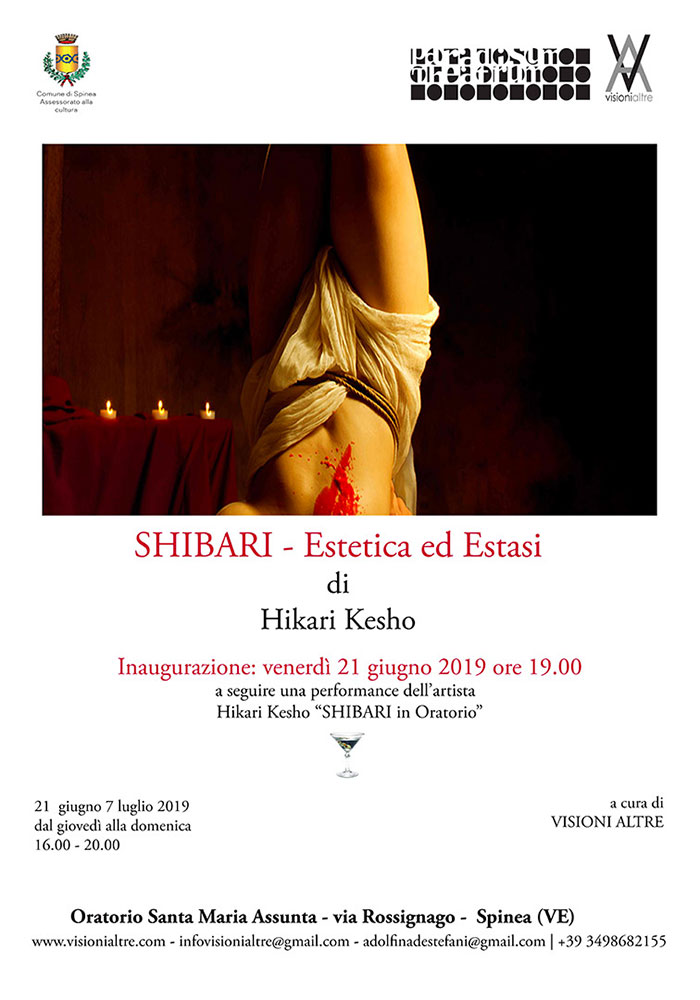


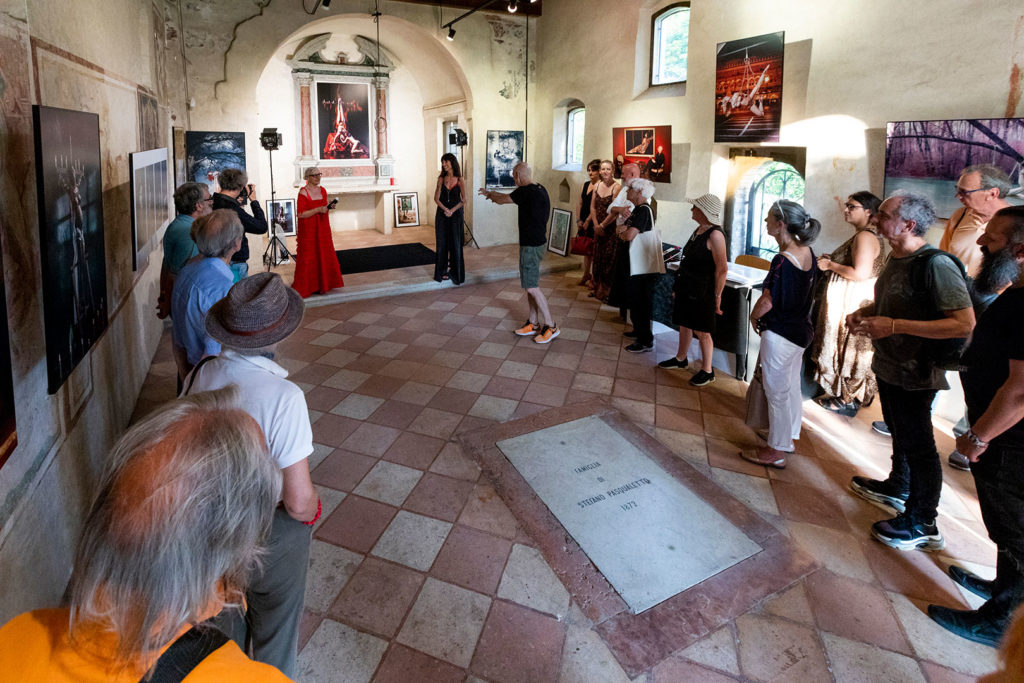


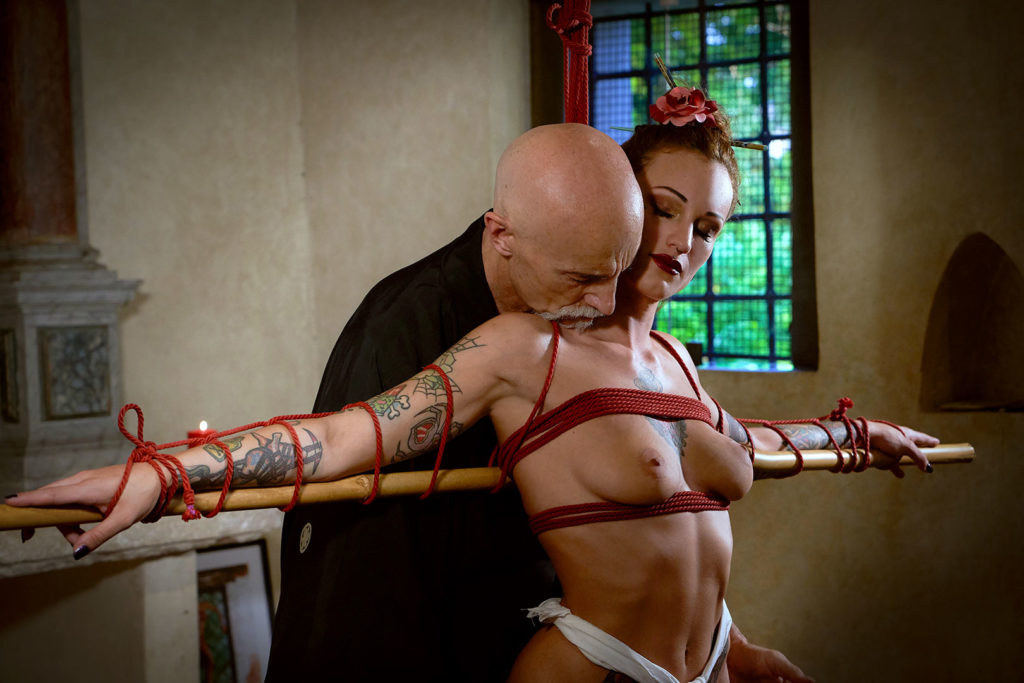
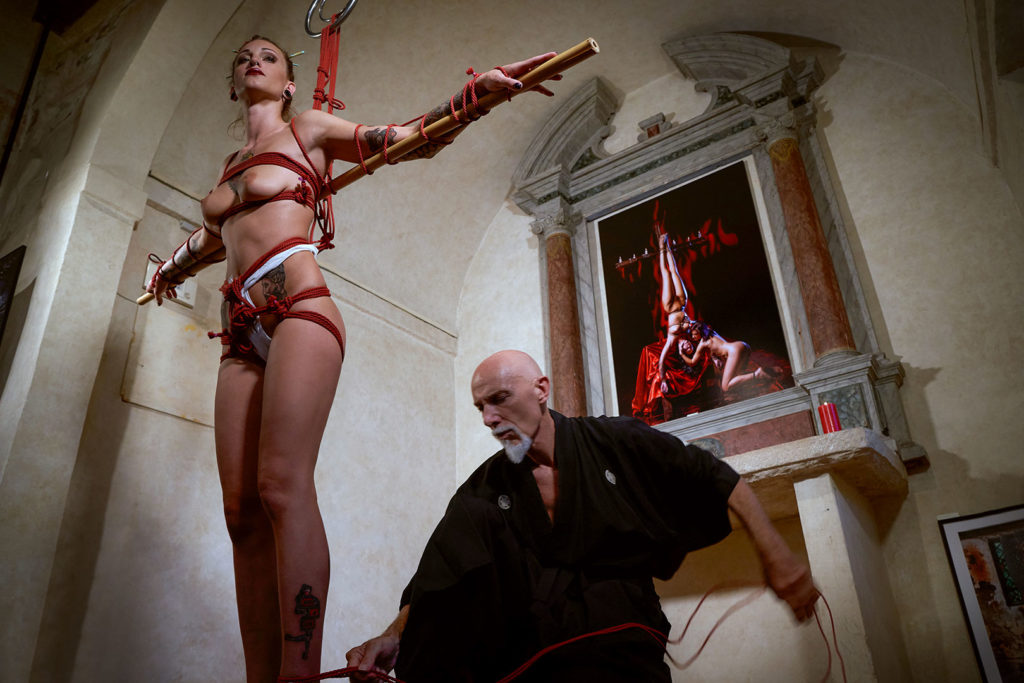
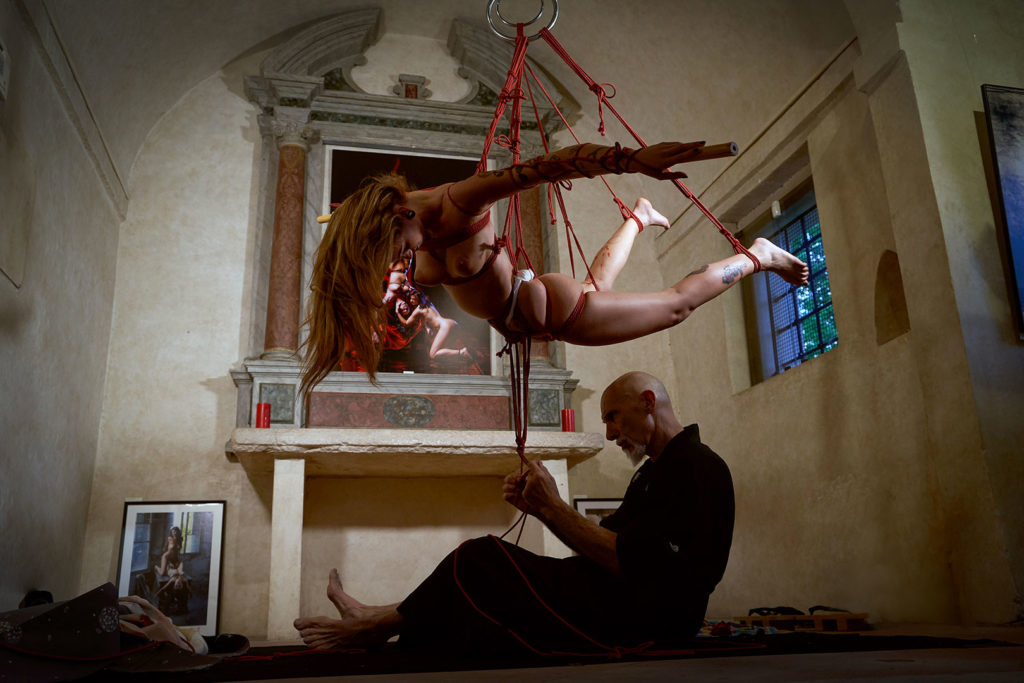
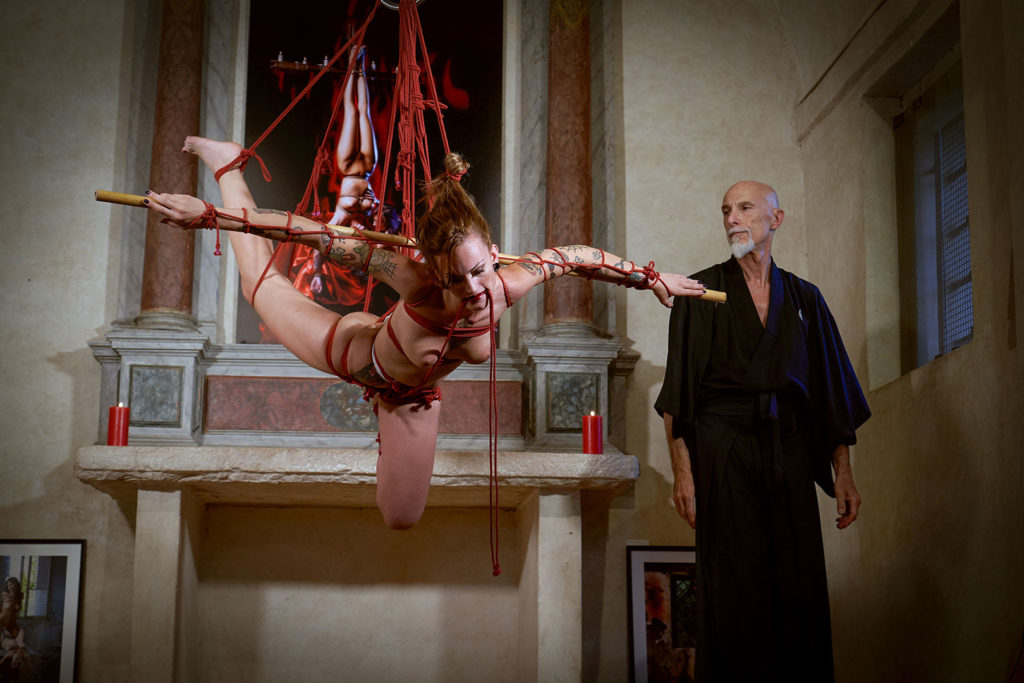

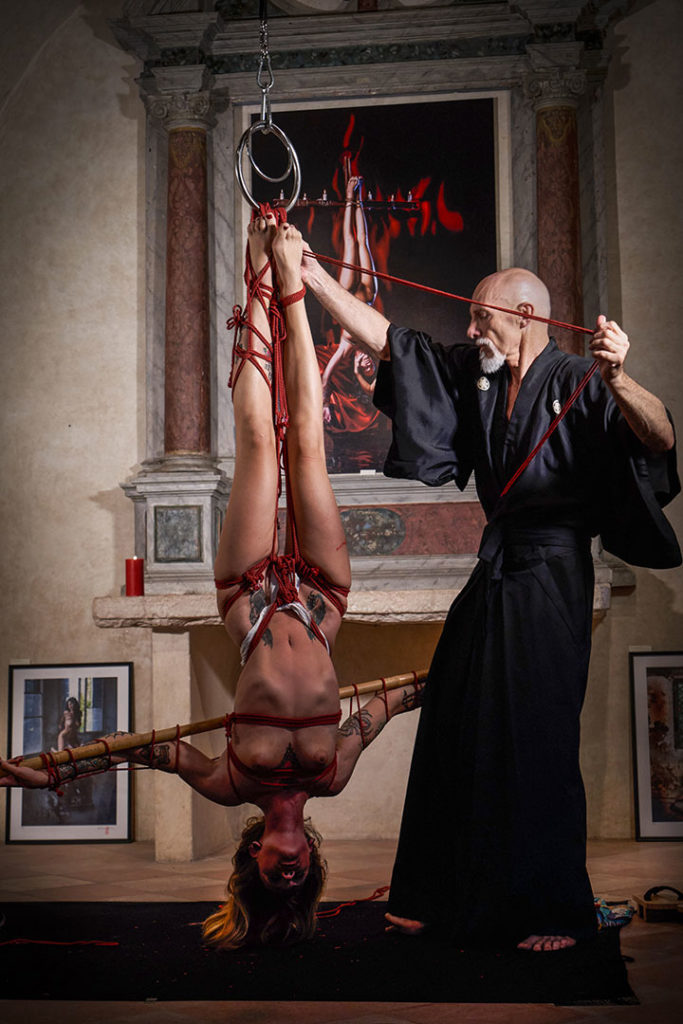



Scrivi la tua!
Commenta questo articolo